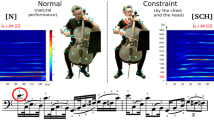Abstract
IN considering the nature of this pipe, and in determining the relation of its air-reed and its air-column, one fact discovered in these investigations should always be borne in mind, that the pitch of the reed is dependent not on vibrating length, but on vibrating divergence—on the amplitude of the reed's motion. The pitch of the air-column is not necessarily the same as the pitch of the air-reed; they may be and often are at variance: and this pipe will afford a happy means of demonstration of the statement made in a previous letter, that the tone of every organ-pipe is dual. As regards the reed, whatever the modifications of length by height of mouth, of thickness by varied wind-way, or of strength by amount of wind-pressure, the final result is bound by this law of divergence. In the typical air-reed, any deviation from the direct line of force taken by the stream of air is the beginning of vibration; its highest possible rate of vibration begins existence on its least divergence from the direct line; consequently, its highest pitch is its inceptive tone at this stage or condition of untamed energy. The bass has always been considered the basis and commencement of musical tone; every relation of tones has been examined on that ground, and it has undoubtedly been the source of many errors, one might almost say in the nature of superstitions, so tenacious has been its hold, so blinding its influence on the perceptions. Tone has its beginnings in the highest activity, and descends to the lowest and slowest; the development of its mechanical relations proceeds by definite degrees, and the issue depends on the affinity existing between the pipe and the reed, both possessing definite form, power, and character, and blending these by law. The vibration of the aëroplastic reed is thus shown to be isotonic, not isochronous; the laws of its vibrations are identical with those of the things most like itself, of sound-waves, of light-waves.
This is a preview of subscription content, access via your institution
Access options
Subscribe to this journal
Receive 51 print issues and online access
$199.00 per year
only $3.90 per issue
Buy this article
- Purchase on Springer Link
- Instant access to full article PDF
Prices may be subject to local taxes which are calculated during checkout
Similar content being viewed by others
Rights and permissions
About this article
Cite this article
SMITH, H. On the Building up of the Tone in the “Gamba” Organ-pipe. Nature 11, 325–327 (1875). https://doi.org/10.1038/011325a0
Issue Date:
DOI: https://doi.org/10.1038/011325a0
Comments
By submitting a comment you agree to abide by our Terms and Community Guidelines. If you find something abusive or that does not comply with our terms or guidelines please flag it as inappropriate.



